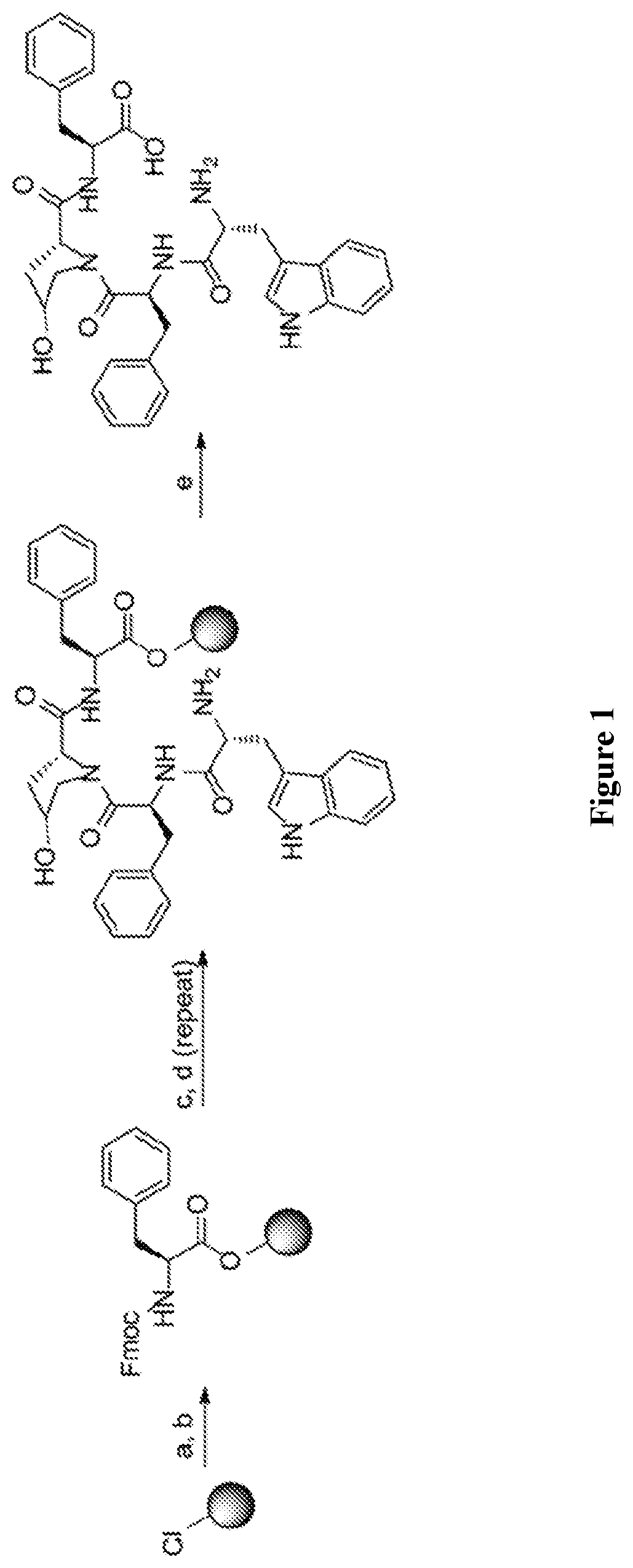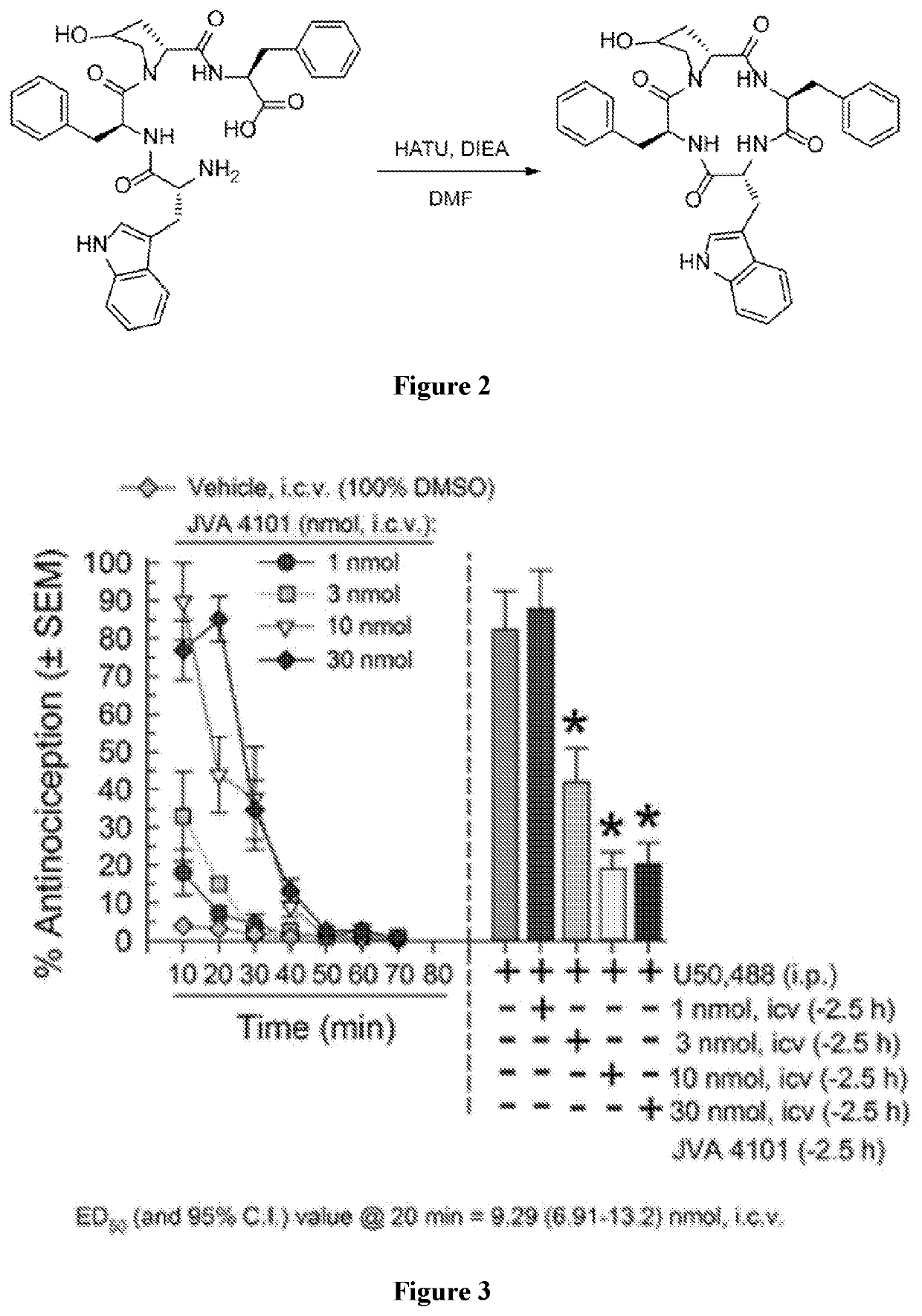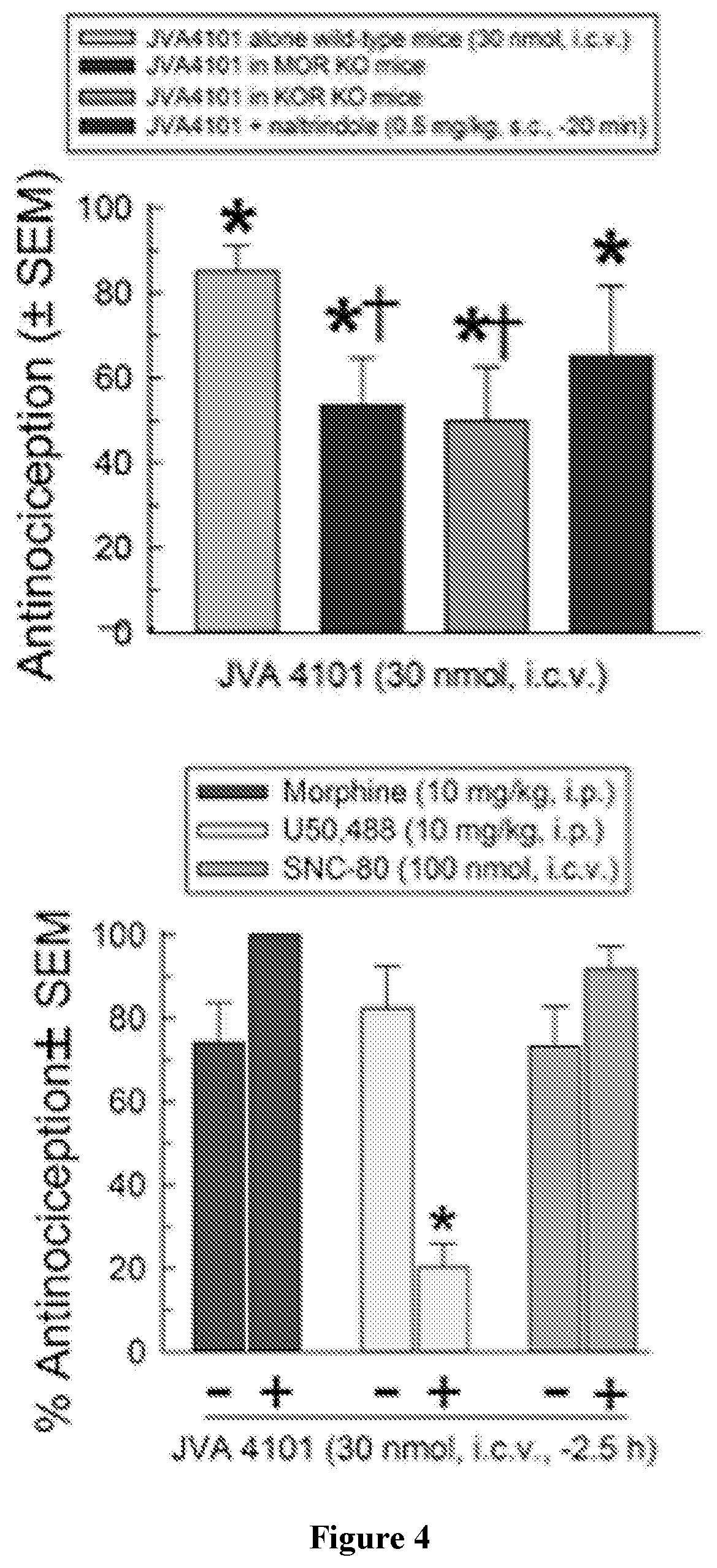Macrocyclic peptides and derivatives thereof with opioid activity
a macrocyclic peptide and derivative technology, applied in the direction of peptides/protein ingredients, peptides, tetrapeptides, etc., can solve the problems of limiting clinical development, undesirable side effects, and drug addiction, and limiting the use of drugs
- Summary
- Abstract
- Description
- Claims
- Application Information
AI Technical Summary
Benefits of technology
Problems solved by technology
Method used
Image
Examples
example 1
nd Binding Assay
[0430]Compounds of the invention can be evaluated for opioid receptor affinities at KOR, MOR, and DOR in radioligand binding assays using well established procedures [Arttamangkul, S., Ishmael, J. E., Murray, T. F., Grandy, D. K., DeLander, G. E., Kieffer, B. L., and Aldrich, J. V. (1997) Synthesis and opioid activity of conformationally constrained Dynorphin A analogues J Med Chem 40, 1211-1218]. Briefly, opioid binding studies can be conducted on membranes derived from CHO cells stably expressing cloned (e.g., from rat) KOR, MOR, and DOR. Multiple (e.g., 12) different concentrations ranging from 0.1 nM to 10 μM of the compound are incubated with isolated membrane protein for approximately 90 mins in 50 mM Tris (pH 7.4) at 22° C. using [3H]-diprenorphine (Kd=0.45 nM), [3H]-DAMGO ([D-Ala2,NMePhe4,glyol]enkephalin, Kd 0.49 nM) and [3H]-DPDPE (cyclo[D-Pen2,D-Pen]enkephalin, Kd 1.76 nM) as the radioligands for κ, μ and δ opioid receptors, respectively. A radioligand bin...
example 3
ughput FLIPR Membrane Potential Assay
[0434]Compounds of the invention can be assessed for their opioid agonism and antagonism potential in a high throughput format (FLIPR II) using the FLIPR Membrane Potential (FMP Blue) assay to measure opioid agonist-induced hyperpolarization according to previously published protocols [Whiteaker, K. L., Gopalakrishnan, S. M., Groebe, D., Shieh, C. C., Warrior, U., Burns, D. J., Coghlan, M. J., Scott, V. E., and Gopalakrishnan, M. (2001) Validation of FLIPR membrane potential dye for high throughput screening of potassium channel modulators J Biomol Screen 6, 305-312; George, J., Baden, D. G., Gerwick, W. H., and Murray, T. F. (2012) Bidirectional influence of sodium channel activation on NMDA receptor-dependent cerebrocortical neuron structural plasticity. Proc Natl Acad Sci USA 109, 19840-19845]. The assay has been optimized the FMP Blue assay to detect opioid receptor mediated hyperpolarization of CHO cells. This assay can quantify either posit...
example 4
f Dyn a from Cortical Neurons
[0435]The release of Dyn A from cortical neurons or a model cell line induced by the compounds of the invention under both control and depolarizing (25 mM K+) conditions can be determined, using procedures previously described [Josefsen, K., Buschard, K., Sorensen, L. R., Wollike, M., Ekman, R., and Birkenbach, M. (1998) Glucose stimulation of pancreatic beta-cell lines induces expression and secretion of dynorphin Endocrinology 39, 4329-4336; Yakovleva, T., Bazov, I., Cebers, G., Marinova, Z., Hara, Y., Ahmed, A., Vlaskovska, M., Johansson, B.,
Hochgeschwender, U., Singh, I. N., Bruce-Keller, A. J., Hurd, Y. L., Kaneko, T., Terenius, L., Ekstrom, T. J., Hauser, K. F., Pickel, V. M., and Bakalkin, G. (2006) Prodynorphin storage and processing in axon terminals and dendrites FASEB J 20, 2124-2126]. Dyn A can be quantified using a radio- or fluorescent enzyme-linked immunoassay (Phoenix Pharmaceuticals).
PUM
| Property | Measurement | Unit |
|---|---|---|
| emission wavelength | aaaaa | aaaaa |
| absorption wavelength | aaaaa | aaaaa |
| diameter | aaaaa | aaaaa |
Abstract
Description
Claims
Application Information
 Login to View More
Login to View More - R&D
- Intellectual Property
- Life Sciences
- Materials
- Tech Scout
- Unparalleled Data Quality
- Higher Quality Content
- 60% Fewer Hallucinations
Browse by: Latest US Patents, China's latest patents, Technical Efficacy Thesaurus, Application Domain, Technology Topic, Popular Technical Reports.
© 2025 PatSnap. All rights reserved.Legal|Privacy policy|Modern Slavery Act Transparency Statement|Sitemap|About US| Contact US: help@patsnap.com



